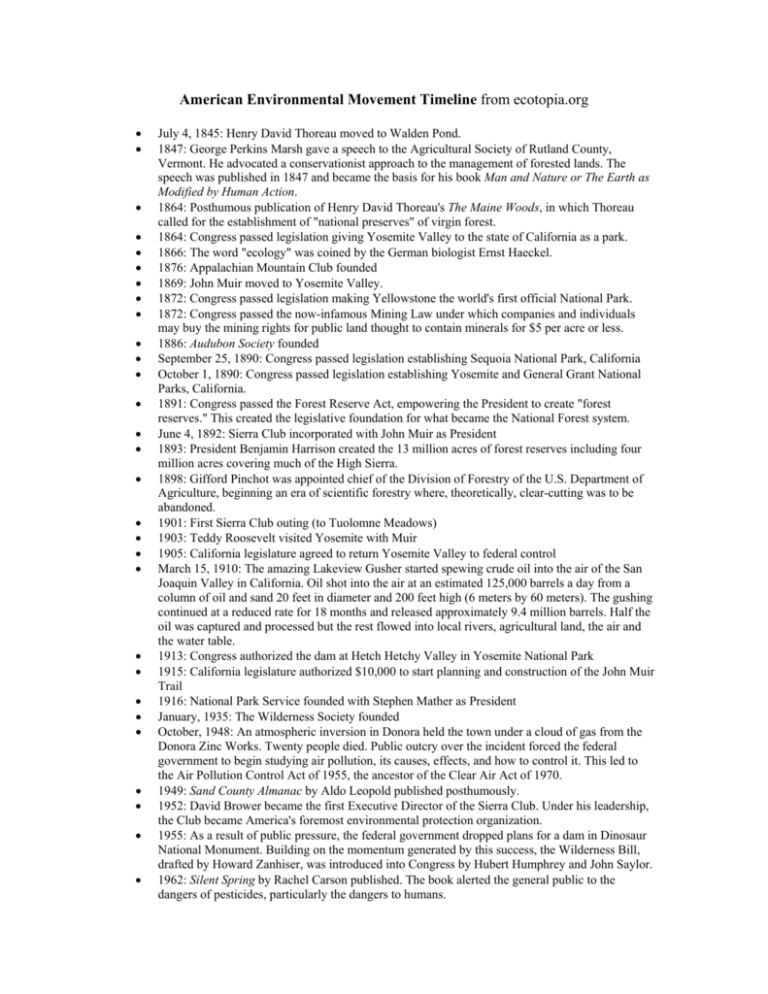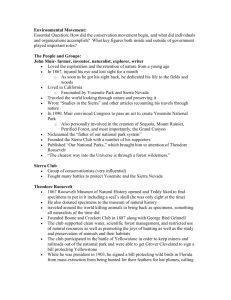Environmental Movement Timeline
advertisement

American Environmental Movement Timeline from ecotopia.org • • • • • • • • • • • • • • • • • • • • • • • • • • • • • July 4, 1845: Henry David Thoreau moved to Walden Pond. 1847: George Perkins Marsh gave a speech to the Agricultural Society of Rutland County, Vermont. He advocated a conservationist approach to the management of forested lands. The speech was published in 1847 and became the basis for his book Man and Nature or The Earth as Modified by Human Action. 1864: Posthumous publication of Henry David Thoreau's The Maine Woods, in which Thoreau called for the establishment of "national preserves" of virgin forest. 1864: Congress passed legislation giving Yosemite Valley to the state of California as a park. 1866: The word "ecology" was coined by the German biologist Ernst Haeckel. 1876: Appalachian Mountain Club founded 1869: John Muir moved to Yosemite Valley. 1872: Congress passed legislation making Yellowstone the world's first official National Park. 1872: Congress passed the now-infamous Mining Law under which companies and individuals may buy the mining rights for public land thought to contain minerals for $5 per acre or less. 1886: Audubon Society founded September 25, 1890: Congress passed legislation establishing Sequoia National Park, California October 1, 1890: Congress passed legislation establishing Yosemite and General Grant National Parks, California. 1891: Congress passed the Forest Reserve Act, empowering the President to create "forest reserves." This created the legislative foundation for what became the National Forest system. June 4, 1892: Sierra Club incorporated with John Muir as President 1893: President Benjamin Harrison created the 13 million acres of forest reserves including four million acres covering much of the High Sierra. 1898: Gifford Pinchot was appointed chief of the Division of Forestry of the U.S. Department of Agriculture, beginning an era of scientific forestry where, theoretically, clear-cutting was to be abandoned. 1901: First Sierra Club outing (to Tuolomne Meadows) 1903: Teddy Roosevelt visited Yosemite with Muir 1905: California legislature agreed to return Yosemite Valley to federal control March 15, 1910: The amazing Lakeview Gusher started spewing crude oil into the air of the San Joaquin Valley in California. Oil shot into the air at an estimated 125,000 barrels a day from a column of oil and sand 20 feet in diameter and 200 feet high (6 meters by 60 meters). The gushing continued at a reduced rate for 18 months and released approximately 9.4 million barrels. Half the oil was captured and processed but the rest flowed into local rivers, agricultural land, the air and the water table. 1913: Congress authorized the dam at Hetch Hetchy Valley in Yosemite National Park 1915: California legislature authorized $10,000 to start planning and construction of the John Muir Trail 1916: National Park Service founded with Stephen Mather as President January, 1935: The Wilderness Society founded October, 1948: An atmospheric inversion in Donora held the town under a cloud of gas from the Donora Zinc Works. Twenty people died. Public outcry over the incident forced the federal government to begin studying air pollution, its causes, effects, and how to control it. This led to the Air Pollution Control Act of 1955, the ancestor of the Clear Air Act of 1970. 1949: Sand County Almanac by Aldo Leopold published posthumously. 1952: David Brower became the first Executive Director of the Sierra Club. Under his leadership, the Club became America's foremost environmental protection organization. 1955: As a result of public pressure, the federal government dropped plans for a dam in Dinosaur National Monument. Building on the momentum generated by this success, the Wilderness Bill, drafted by Howard Zanhiser, was introduced into Congress by Hubert Humphrey and John Saylor. 1962: Silent Spring by Rachel Carson published. The book alerted the general public to the dangers of pesticides, particularly the dangers to humans. • • • • • • • • • • • • • • • • • • • • • • • 1964: The Wilderness Act passed, establishing a process for permanently protecting some lands from development. 1965: The Sierra Club brought suit to protect New York's Storm King Mountain from a power project. The case established a precedent, allowing the Club standing for a non-economic interest in the case. June, 1966: Sierra Club published full-page newspaper ads in the New York Times and Washington Post against building a dam that would flood the Grand Canyon. The next day, the IRS hand-delivered a suspension of the Club's tax-exempt status. This action boosted the Club's prestige and membership and helped in the fight to save the Canyon. The ad in question said simply, "This time it's the Grand Canyon they want to flood. The Grand Canyon." 1968: Grand Canyon dam plan killed. 1969: Santa Barbara Oil Spill -- Oil from Union Oil's offshore wells fouled beaches in Southern California and aroused public anger against pollution. 1969: National Environmental Policy Act passed and Environmental Protection Agency created. 1970: Clean Air Act passed, greatly expanding protection began by the Air Pollution Control Act of 1955. April 22, 1970: the first Earth Day 1972: DDT banned in US. 1972: Water Pollution Control Act overwhelmingly passed over a presidential veto. Dec. 28, 1973: The Endangered Species Act was passed. In the famous decision of 1977 (see below) the Supreme Court validated the principles of this Act. Since then, it has become one of the most powerful tools in the continuing effort to protect the environment in the U.S. June 15, 1977: The U.S. Supreme Court upheld the 1973 Endangered Species Act and stopped construction of the Tellico Dam. August, 1978: President Carter declared an emergency at Love Canal. The Love Canal scandal alerted the country to the long-term, hidden dangers of pollution of soil and groundwater. March 28, 1979: Three Mile Island nuclear power plant almost had a meltdown, giving the nuclear power industry a permanent black eye. 1980: Congress passed the Alaska National Interest Lands Conservation Act, designating over100 million acres of parks, wildlife refuges, and wilderness areas. April 26, 1986: The Number Four reactor at Chernobyl suffered a disastrous explosion and fire. Thirty-one people died in the days after the accident and many thousands were subjected to radiation. The nuclear power industry has never recovered from the effects of the publicity given to this, the worst nuclear accident to date. March 24, 1989: Exxon Valdez disaster. September 28, 1994: Mono Lake -- court decided minimum stream flows must be maintained. 1994: Unocal diluent spill discovered. -- An 8.5 million gallon spill of diluent was discovered at Unocal's Guadalupe oil field. This is the second largest known spill in California history -- so far. (See 1910 for the largest.) Dec. 10, 1997: A 23-year-old woman named Julia Butterfly Hill climbed into a 55-meter (180 foot) tall California Coast Redwood tree. Her aim was to prevent the destruction of the tree and of the forest where it had lived for a millennium. September 17, 1998: David "Gypsy" Chain was killed by a tree felled by employees of Pacific Lumber/Maxxam Corporation. Chain was in the forest protesting the destruction of some of the last remaining old-growth redwood trees in the world. December 18, 1999: Julia Butterfly Hill came down from “Luna” after concluding a deal with Pacific Lumber/Maxxam Corporation to save the tree and a three-acre buffer zone. February 16, 2005: The Kyoto Protocol comes into effect. Almost all countries in the world are now pledged to reduce the emission of gasses that contribute to global warming.







